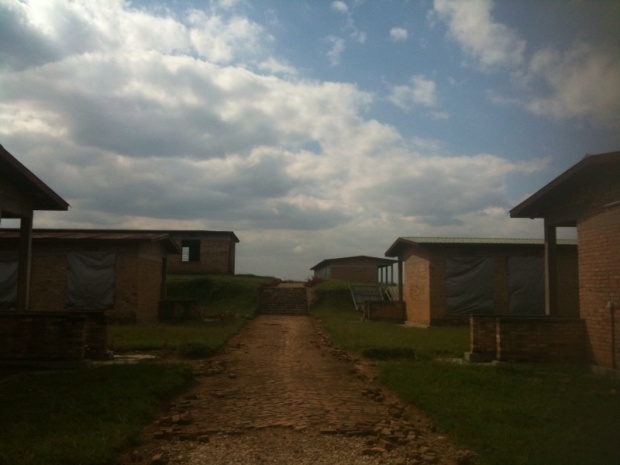It’s interesting to experience that the guy who is supposed to watch children from drowning tries to rescue me from drowning in my non Christian beliefs.
At the Serena Hotel I was yesterday, teaching the hotel guest Yoga. It was a nice class and after this I went for a nice and freezing dip in Serena’s luxurious swimming pool. The guard who was watching starts to speak in French to me, and in the beginning I just acted as if I understood everything. Which i didn’t. I understand the outlines of his speech but he kept going and going and after a while I had to admit that my French is not that fluently.
He smiled brightly and without hesitation he kept talking and changed his language into English. At least now I could understand.
He spoke about God and how wonderful life is, all created by the Lord. I smiled and listened. When he asked me “Don’t you think?”, I had to make another confession, one that he, i found later, didn’t understand at all. I told him my view on God and that I believe that All is God, but also nothing is God. We are, Jesus is, Allah might be as well, Buddha was… it’s all the same, different name. And I added that I believe that if nobody would judge eachother on their beliefs or let eachother be free to believe or not, or what to believe in and find peace at, there would be less or even maybe no war in the world.
He seemed to have a hard time to let me finish my sentence and before I knew he showed his bright white teeth again and continued his preach about creation and the creator. He points at a little girl playing in the pool, and asks me if this can exist without a creator? And he tells how not innocent people are when they are born, etcetera….
A few times, here in Rwanda the religion conversation started and just by telling them that many people in The Netherlands do not go to church or do not believe in God, make their eyes roll out of their skull almost. They would shake their heads, from left to right. No, no, no… That’s very very hard to believe…
Then, interesting is, that in the book I was reading (La stratégie des antilopes) I read about religion in Rwanda too. And what the Genocide changed in the way people believe. I read that many do not believe in God anymore, they gave up after they saw their whole family was slaughtered in front of their eyes of had to crawl in the mud for days, weeks to escape the (final) cut of the machetes. Or they do believe in God as a creator, but not believe that He offers help or support. Many do not go to Church anymore, because of tragic what happened IN the Church even. One story was told, that the priest asked the people who were on the run, to get into Church to become safe. They would trust the priest and could look for shelter in Church with their babies, parents, families… until 3 days later, without a word the priest disappears in a big car, fast as lightning without saying goodbye, without wishing them luck or anything… and everyone in Church would become a victim of these machetes. Death. Young and old. Fooled by the priest. Then, who cán you believe? Also nowadays, the murderers who came out of jail, would be front row in Church taking the Holy Communion tree times and tell how happy they are that they are forgiven, while the person who lost all his family under the hands of that same murderer next to him is just watching and see this every Sunday, over and over again. The people in the mud, hiding from being murdred would listen secretly to small radio’s, hoping every day to hear that the Pope in Rome is telling all the murderers to not kill their children. But without any result. They never heard the Pope. And the murdering continued. What also changed, i read, after the Genocide is, that people switch church all the time now. Sometimes 3 times a year! While before, if one was born Catholic, probably he would die Catholic. Which doesn’t seem to be the case anymore.
So, I am wondering. Who is believing what? Why are they believing? I believe they are on a search, a search for God. A search for themselves.
In Yoga class i hear women telling me that they didn’t ‘felt’ their bodies, the didn’t feel their muscles. When they started to learn about yoga, that feeling came back. They feel themselves again. Yoga is teaching people to be aware of themselves. Simply be aware of your breath, your legs and your fingers. In my opinion, that’s the best search you can be on. Once you find yourself (back), or you become aware of who you always were, just be aware, you are aware to choose which God can add something to your own stability instead of completely depend on external factors and drown in that.
The guard at the swimming pool added that he saw me teaching Yoga that morning and imitated me by showing Virabhadrasana A (Warrior pose), exaggerating the inhalation and exhalation and said in another exaggerating way, looking at me with eyes as if they would spit fire soon: “And then you are loooooking for that pleasure far away, take you up, high, you want to find it far away and take it…” and I replied calmly: “No, nothing far away. But as close as can be. In yourself. That’s where we look. Standing on the floor with both feet.”
He smiled big and didn’t seem to believe me. I invited him for class next Saturday. But he just smiled.
Namaste! Anneke






